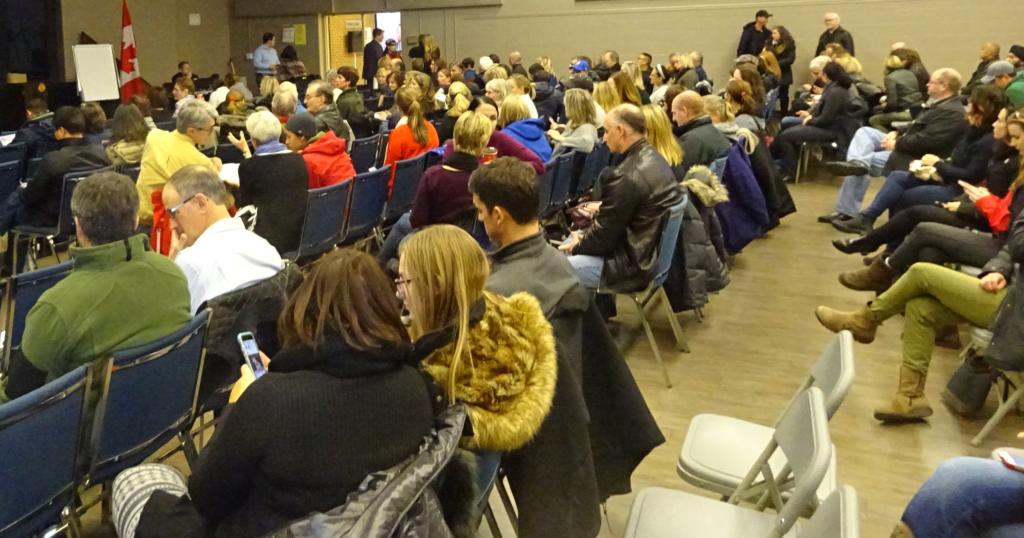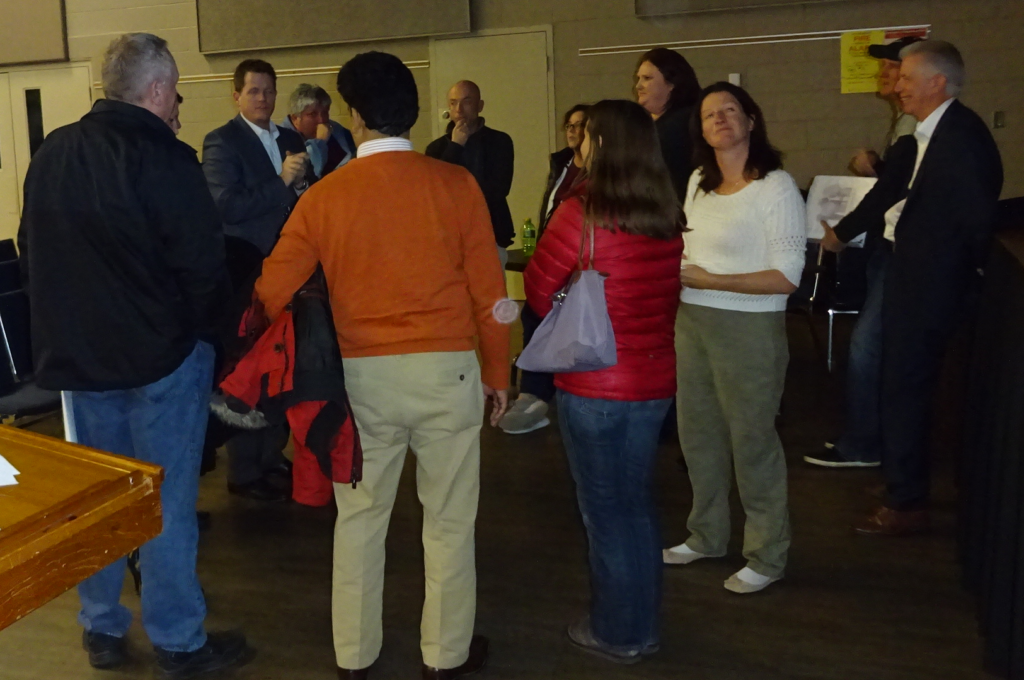January 20th, 2017
BURLINGTON, ON
Part 5 of a series
Tom Muir, an Aldershot resident, has been an active participant in civic affairs or more than 25 years. He has been described as “acerbic”, a fair term for Tom.
He has outlined, in considerable length, a large part of why the parents at Central and Pearson high schools are in the mess they are in as a result of the recommendation to close their schools. In this article, one of a series Muir suggest what he feels are obvious solutions to the problem the Board of Education believes it has. There is a lot of material; it gets dense at times. Living in a democracy means you have to accept the responsibility of citizenship and stay informed.
The Gazette published the results of the 25 questions put to residents at the public meeting held by the Board on December 8.
There has been some concern expressed that the responses may be biased because of the representation by school is not even.
This is because all of the schools are not explicitly named as the primary option for closures, so there is a selection bias built right into the sampling frame itself, used by the Board consultant.
This sample of the resident/parent/student populations reflects the selection of schools that are directly named for closure or other changes – Central, Pearson, and Hayden. It is expected that the population of these schools would self-select to participate.
The low turnout from the other schools is also expected on similar grounds as not being in the selected schools directly affected.

These are the parents that answered the 25 questions put to them by the Ipsos facilitator the Board of education hired to collect and analyze the data. The vast majority of them were from Central high school.
In my opinion, the selection of schools is biased, so the turnout population sample reflects this bias – in effect the net bias balances out.
This is my summary of the details of the responses. The opposite views and votes are found by subtraction from 100%.
When you consider these closely, you can see what parents think about what they were asked, and what they want.
We have set out all 25 questions and the responses to each question – they are shown in red.
The Questions and the responses:
Question 1: Which high school are your representing tonight? The number beside the school was the number people in the audience would key in. The screen displayed a number that indicated how many devices had been handed out and another number showing how many people had responded.
7. Aldershot 7
6. Dr. Frank J. Hayden 43
5. Lester B. Pearson 43
4. Nelson Public 6
3. Robert Bateman 5
2. Burlington Central 150
1. M.M. Robinson 2
Question 2: How important is the availability of mandatory / core courses for your child(ren) within your home school?
3. Very Important 187
3. Somewhat Important 58
2. Not Very Important 12
1. Not at all Important 3
Question 3: How acceptable is it to attend a school outside of a home school for mandatory / core programming for your child(ren)?
4. Very Acceptable 22
3. Somewhat Acceptable 42
2. Not Very Acceptable 64
1. Not at all Acceptable 135
Question 4: How important is the availability of optional / elective courses within your home school for your child(ren)?
4. Very Important 94
3. Somewhat Important 117
2. Not Very Important 38
1. Not at all Important 14
Question 5: How acceptable is it for your child(ren) to attend a school outside of a home school for optional/elective courses?
4. Very Acceptable 37
3. Somewhat Acceptable 92
2. Not Very Acceptable 70
1. Not at all Acceptable 62
Question 6: How willing are you to have your child(ren) take a mandatory/core course in an alternative method (e.g., summer school, night school, e-learning or attend another school?
4. Very Willing 55
3. Somewhat Willing 54
2. Not Very Willing 57
1. Not at all Willing 96
Question 7: How willing are you to have your child(ren) take a optional/elective course in an alternative method (e.g., summer school, night school, e-learning or attend another school?
4. Very Willing 90
3. Somewhat Willing 74
2. Not Very Willing 46
1. Not at all Willing 49
Question 8: How important is it for you high school to offer a full range of pathway programming (e.g., workplace, college, university)?
4. Very Important 120
3. Somewhat Important 89
2. Not Very Important 33
1. Not at all Important 15
Question 9: How concerned are you that your child(ren) has access to appropriate learning facilities (e.g., kitchens, science labs, gyms, libraries)?
4. Very Concerned 165
3. Somewhat Concerned 58
2. Not Very Concerned 16
1. Not at all Concerned 19
Question 10: How concerned are you that some high schools have large amounts of specialized learning spaces that remain underutilized?
4. Very Concerned 18
3. Somewhat Concerned 56
2. Not Very Concerned 92
1. Not at all Concerned 92
Question 11: How important is it for your home school to have a full range of extracurricular activities (e.g., drama, arts, athletics, clubs) for your child(ren)?
4. Very Important 121
3. Somewhat Important 92
2. Not Very Important 35
1. Not at all Important 13
Question 12: How likely are you to support your child(ren) participating in extracurricular activities at another school?
4. Very Likely 72
3. Somewhat Likely 69
2. Not Very Likely 49
1. Not at all Likely 68
Question 13: How important is it for your child to have access to the highest level of competition in athletics?
4. Very Important 19
3. Somewhat Important 30
2. Not Very Important 170
1. Not at all Important 141
Question 14: How important is the physical condition of your existing school to you (e.g., environmental sustainability, energy consumption, safety)?
4. Very Important 75
3. Somewhat Important 37
2. Not Very Important 32
1. Not at all Important 95
Question 15: How important is it to you that the board ensures schools have an up-to-date, fully-accessible learning environment (e.g., elevators, air conditioning)?
4. Very Important 56
3. Somewhat Important 38
2. Not Very Important 32
1. Not at all Important 116
Question 16: How important is it you to preserve existing community partnerships at your child(ren)’s current school (e.g., swimming pool, library, community centre)?
4. Very Important 97
3. Somewhat Important 36
2. Not Very Important 49
1. Not at all Important 69
Question 17: How important is it you to minimize the use of portable classrooms?
4. Very Important 159
3. Somewhat Important 27
2. Not Very Important 27
1. Not at all Important 39
Question 18: The Board’s current walk distance is a maximum of 3.2 km. How important is it that your child(ren) are within the Board mandated walking distance to reach school?
4. Very Important 198
3. Somewhat Important 22
2. Not Very Important 21
1. Not at all Important 12
Question 19: Which of the following is your child(ren)’s most common form of travel to school currently? (list methods)
6. School Bus 37
5. Car (drive or drop off) 32
4. Public Transit 0
3. Walk 176
2. Bike 17
1. Other 4
Question 20: How important is it to you that the Board be fiscally responsible by reducing transportation to reach school?
4. Very Important 151
3. Somewhat Important 44
2. Not Very Important 22
1. Not at all Important 30
Question 21: How important is it for your child(ren) to spend their secondary school years in one school community?
4. Very Important 238
3. Somewhat Important 14
2. Not Very Important 6
1. Not at all Important 0
Question 22: The Ministry does not fund empty pupil places. To what extent do you agree that the Board should reallocate its limited budget to fund these spaces?
4. Strongly Agree 122
3. Somewhat Agree 50
2. Somewhat Disagree 32
1. Strongly Disagree 28
Question 23: The Board’s MYP states it will maintain a minimum overall average of 90% building capacity. To what extent to do you agree with this goal around future sustainability of Burlington secondary schools?
4. Strongly Agree 20
3. Somewhat Agree 34
2. Somewhat Disagree 53
1. Strongly Disagree 134
Question 24: The goal in the current MYP is to use innovative approaches to student learning spaces (e.g., classrooms, gymnasiums). To what extent do you feel the current situation of Burlington high schools is sustainable?
4. Very Sustainable 91
3. Somewhat Sustainable 55
2. Not very Sustainable 20
1. Not at all Sustainable 25
At this point people began walking out. Answers for the 25th question were not collected.
Question 25: Of the four themes, which is most important to you?
4. Programming and enrollment 0
3. Physical state of existing schools 0
2. Geographical and transportation Issues 0
1. Fiscal responsibility and future planning 0

Very little is known about the parents who are members of the Program Accommodation Review Committee other than that they have a tremendous amount of work ahead of them. There is no remuneration for the members of the committee.
Tom Muir’s analysis of the answers that were given to the questions asked.
Readers are going to have to shift up and down the pages to read the question and all the responses Muir has analyzed. Awkward – but it was the only way to set the data out for readers.
1) It is apparently important there be no school closures:
– the Board allocate the budget to fund empty spaces (Q22, 74%);
– present empty spaces are sustainable (Q24, 76%) – question also said MYP goal is to use innovative approaches to learning space use;
– response disagrees with Board 90% utilization goal (Q23, 78%);
– response not concerned about empty spaces being underutilized (Q10, 71%).
2. The importance of the home schools for core/mandatory subjects, and even optional/elective, is quite emphatic (Q2, 94%; Q3, 76%; Q4 80%; Q6, 58%; Q5, 51%), and consistent;
– Q7 indicates some support (63%, but only 35% are very willing), for optional/elective in alternatives like summer school, night school, e-learning, another school.
– do not agree with the Board 90% utilization goal (Q23,78%);
– and again, want the Board to allocate the budget to fund empty spaces (Q22, 74%);
– see being within 3.2 km, or 2 mile, Board mandated walking distance to home schools as important (Q18, 86%) – 69% already walk, 14.5% ride bus (Q19);
– see reduction in bus transportation to each school as important (Q20, 79%);
– see spending secondary years in one school as important (Q21, 98%);
– are concerned that appropriate learning facilities be accessible (Q9, 86%);
– want a full range of pathway programs (Q8, 81.3%);
– feel current situation is sustainable – as above in 1. (Q24, 76%);
– see it as important to minimize the use of portables (Q17, 74%).
4. Suggesting further support for retaining all schools are the following:
– a full range of extra-curricular activities (e.g., drama, arts, athletics, clubs) is important (Q11, 82%) – in my view, this implies more schools with more space for fewer students, means more opportunities;
– parental support to help students do extracurricular at another school is not at all likely, or not very likely, for 45% of respondents, compared to 55% at somewhat or very likely (Q12);
– the importance of the highest level of competition in athletics is not important (Q13, 81%) – in my view, this implies the larger top tier schools with large student populations are not important in this regard.
5. Other parent/resident views reflect a small majority percent expressing that:
– the physical condition of the school as not at all or very important (Q14, 53%);
– that the importance of the school as up-to-date and fully accessible, with elevators and air conditioning, is not at all or not very important (Q15, 61%);
– preserving existing community partnerships at current school (pools, libraries, community center) is very to somewhat important (Q16, 53%).
Again, the opposite views and percent support can be derived by subtraction with regard to response preference bracket.
I believe my analysis is accurate. It is unbiased and done in good faith.
 Tom Muir is a resident of Aldershot who has been a persistent critic of decisions made by city council. He turns his attention to the current school board mess. He recently suggested to Burlington city council that “If you are so tired of and frustrated by, listening to the views of the people that elected you, then maybe you have been doing this job too long and should quit.
Tom Muir is a resident of Aldershot who has been a persistent critic of decisions made by city council. He turns his attention to the current school board mess. He recently suggested to Burlington city council that “If you are so tired of and frustrated by, listening to the views of the people that elected you, then maybe you have been doing this job too long and should quit.
Muir explains that the PARC will only get what people send in, what they come up with from their own efforts, and what they ask/demand from the board. They have to decide what they want and go after it ruthlessly. They will have to fight with tooth and claw and take no prisoners.
Previous articles in this multi part series


















